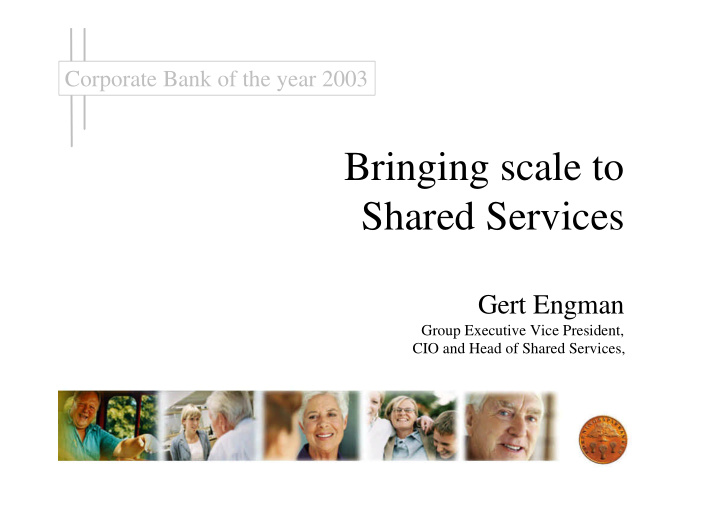



Corporate Bank of the year 2003 Bringing scale to Shared Services Gert Engman Group Executive Vice President, CIO and Head of Shared Services,
1 Agenda • Creation of a Shared Services Unit • Current drivers and trends in IT • IT and a realistic cost dimension • Maximum return on IT investments • IT project portfolio 2004 and beyond
2 Why Shared Services Satisfied customers Create scale and efficiency from tasks performed in many areas but only partially today Services used by other than the performing Cost Growth entity (ies), are candidates for Shared efficiency Services Clear separation in e.g. head office functions between strategy and delivery Competence Branches
3 Shared Services today Shared Services Channel and Support services operations IT development 1 200 staff + 3 billion SEK cost
4 Support Services • Administrative duties in branches are centralized to a few administrative centers, creating increased efficiency at a target ratio of minimum of 2:1, e.g. Loan administration Collections Other daily, non customer focused activities are moved out of the branches • Many other areas where economies of scale applies, e.g.: Training Procurement Staff admin Etc.
5 Channel and Operations Development Unit • New unit responsible for all customer and staff related systems, platforms and applications across channels, i.e. Internet, ATM, branch and telephone. • Allows for cross-channel development and process workflow for increased efficiency in systems development, application maintenance and operations
6 Our IT • 850 IT professionals • ~ 6 000 Mips IBM OS/390, hot and cold • Platforms – IBM OS/390 – Sun Solaris (Unix) – Windows NT (Client/Server) – Oracle – Tandem – NCR Teradata data warehouse
7 Current drivers and trends in IT
8 Current drivers and trends in IT Application and architecture Performance Technical management infrastructure Governance Organization and processes “The IT pentagon”
9 Application and IT architecture Application and architecture Today • Components based – promises re-use, less complexity and shared development • Striving for standards in software, J2EE, Soap, WSDL, Dot.net, etc.) • Multi-layered architecture drives down cost and shortens time to market
10 Architecture revolution Application and architecture ? Complexity Future channel Telephone Internet ? Office ATM Application Layer Future channel Future channel Telephone Telephone Internet Internet Office Office Host Connectivity Layer ATM ATM Common Business Component Layer Infrastructure layer Host Connectivity Layer 2005 1970
11 IT and a realistic cost dimension
12 Transactions and use increase but the cost of IT is constant Middleware transactions/channel – per day average since 2000-01-01 Transactions per day, millions Internetbank Branch ATM Telephone Bank IT costs 2000 –> 2003
13 Beware of the production trap Time
14 Compass award 2003 FSB has conscientiously committed itself to comparative analysis: in part to objectively communicate the competitive strength of its IT organisation to the bank’s management and users and in part to maintain and increase the competitive strength of every part of that IT organisation. One prerequisite for the steady trend of improvements FSB has made is its persistent efforts to convert analysis results into improvements that are continuously followed up. As a result, the bank ranks, in most areas, in the highest international class. Using a fact-based, independent methodology, FSB has been able to prove that large-scale outsourcing is not an unavoidable alternative for large IT organisations. Furthermore, it has created value-added for the bank by allowing it to maintain full control over this key aspect of its operations Nordic companies included in Compass’ peer-group include: Banverket, Danfoss, Vattenfall, EDB Teamco, BRF Kredit, Kommunedata, DSB, RFV, Norsk Hydro,SEB, Telia, Tietoenator, Folksam, Volvo, Vägverket, SchlumbergerSema, Akzo Nobel, Astra, Zeneca, Saab Bofors, Skandia-gruppen, Länsförsäkringar, If, Sampo, Stora Enso, SKF, Posten,Ergo Runit, Gjensidige
15 Maximum return on IT investments
16 Areas to constantly challenge Business development through IT Governance Business and IT Value Idea Development realization generation Optimize development resources Consolidate IT applications and platforms Consolidate IT Infrastructure support Sourcing
17 Potential Areas Description Potential Governance Improve prioritization of development projects Sourcing Alternative sourcing, primarily IT Sharpen procurement process and skills Optimize dev’t Optimize business development resources resources in business units Consolidate Optimize applications landscape applications Consolidate Reduce cost through consolidation support Identified potential Target
18 On-going projects • Replacement of deposit system (core banking) • Components based, real time, multi-bank • Cheaper to maintain and operate • Faster product development (days instead of months) • Web based cash management application for large corporates and municipalies • Replacement of web platform • Same platform for Internet bank, external web and intranet • Cheaper to run, maintain and develop • New distribution middleware platform • More flexible and with standards based interfaces (J2EE)
19 On-going projects • Economic capital/Basel II • Substantial positive effects expected through more efficient capital employment • scoring tool for SME:s • Portals • Personal productivity tool for increased though-put • CRM • Campaign management for better precision in direct marketing to mass market customers
Recommend
More recommend